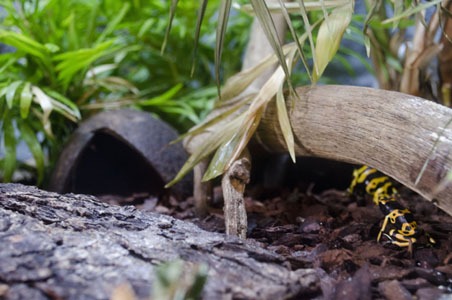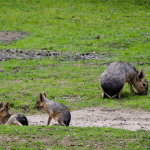New inhabitants in Reptile River

Several new species are now on display in Flamingo Land’s Reptile River area. This section of the zoo is part of Children’s Planet and was already home to our water monitor lizard, Burmese pythons and cane toad. As well as reptiles, amphibians and mammals can be seen there too – our porcupines and meerkats also have enclosures there. The species now on display are poison dart frogs, a blood python, mossy frogs and red-tailed racer snakes.
Red-tailed racers are also known as red-tailed green ratsnakes. If you see ours you’ll be able to recognise them easily by their bright green colour, although don’t bother looking for red tails because they don’t have them! The name is quite misleading as these snakes are not always green and don’t always have red tails. Red-tailed racers are excellent climbers and may spend most of their lives in the trees. They eat birds, eggs, rodents, lizards and bats. They are native to Southeast Asia, being found in countries such as India, Malaysia, Vietnam and Thailand.
Blood pythons are also Southeast Asian snakes, found in Thailand, Malaysia and Indonesia. Our blood python is housed in the same enclosure as the red-tailed racers but they are very easy to tell apart. The blood python is a much stockier snake with greyish-brown colouring. Blood pythons spend much of their time submerged in water, waiting for prey to wander nearby. They eat mice, rats, rabbits and other small mammals.
Mossy frogs are native to northern Vietnam and China. Their skin is mottled green and brown and is also bumpy, resembling moss growing on a rock, which gives them superb camouflage. When frightened they will curl up into a ball and play dead. Mossy frogs are semi-aquatic and spend a lot of time in and around water. However, they are also skilled tree climbers, thanks to the suction-like pads on their feet which help them to grip. They lay their eggs above and out of the water so that they are not eaten by predators. Once the tadpoles hatch, they drop straight into the water below. Tadpoles take 3 months to develop into frogs.
Poison dart frogs are famous for the poison found in their skin. Their bright colouring serves as a warning to other animals that they are poisonous. The toxicity comes from their diet of invertebrates such as ants, so most poison dart frogs in captivity are not actually toxic. There are several species of poison dart frogs and they can be found with a range of bright colours and patterns. At Flamingo Land we have blue ones, yellow and black ones and green and black ones – see if you can spot them all next time you visit!


